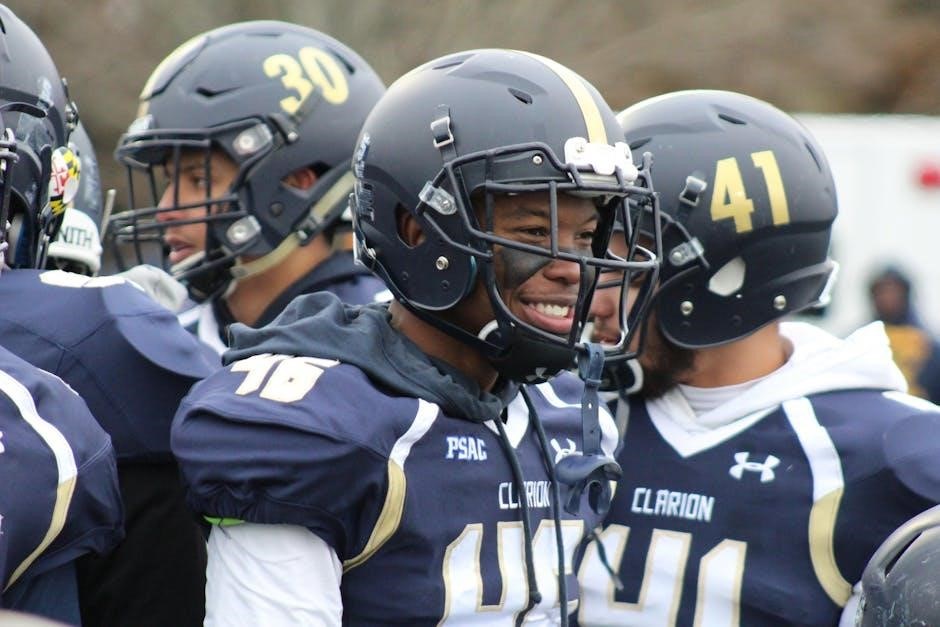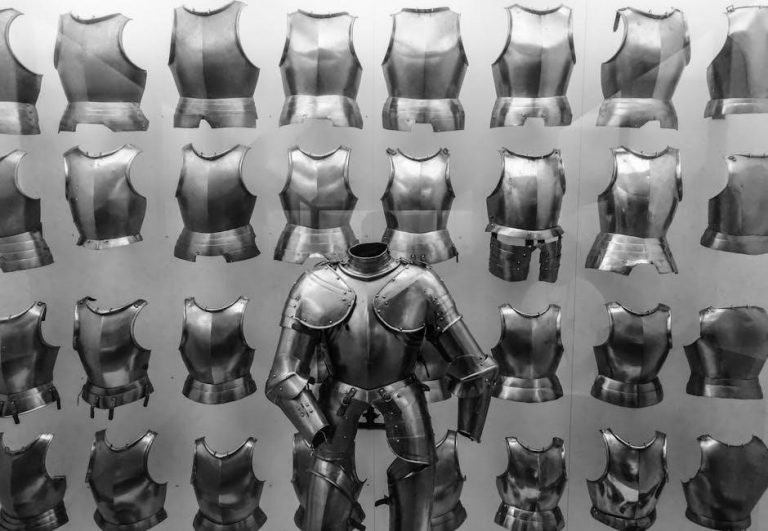The 3-4 Defense Playbook is a strategic guide offering proven schemes, coaching points, and solutions for teams of all sizes, enabling coaches to build a dynamic defense.
Overview of the 3-4 Defense
The 3-4 defense is a versatile and widely used defensive formation in football, featuring three defensive linemen and four linebackers. It emphasizes adaptability, allowing teams to adjust to various offensive formations and tendencies effectively. Known for its ability to create pressure and disrupt offenses, the 3-4 defense is popular in both NFL and college football. Its flexibility enables teams to balance run defense and pass rush while creating opportunities for turnovers, making it a reliable and dynamic defensive strategy.
Importance of the Playbook for Coaches and Teams
The 3-4 Defense Playbook is an essential resource for coaches, offering practical solutions to common defensive challenges. It provides detailed strategies, assignments, and techniques that empower teams to compete effectively, regardless of their size or skill level. By implementing the playbook’s schemes, coaches can enhance their team’s adaptability, create pressure on offenses, and build a cohesive unit capable of stopping both rushing and passing threats. Its comprehensive approach makes it invaluable for achieving defensive success and winning more games.
Key Positions in the 3-4 Defense
The 3-4 defense relies on a nose tackle, two defensive ends, and four linebackers to create a strong, versatile front. These positions are crucial for stopping the run and pressuring the quarterback effectively in various game situations.
Nose Tackle: Role and Responsibilities
The nose tackle is the anchor of the 3-4 defense, requiring a large, physical presence to clog the interior gaps and occupy blockers. Their primary role is to stop the run by absorbing double teams and freeing up linebackers. They must also maintain gap discipline and occasionally rush the quarterback, making them a versatile and critical component of the defense. A dominant nose tackle allows the entire defensive front to function effectively, making them indispensable in this scheme.
Defensive Ends: Strong-Side and Weak-Side
Defensive ends in the 3-4 scheme are versatile players critical to the defense’s success. The strong-side end aligns to the tight end side, focusing on containment and setting the edge, while the weak-side end often faces fewer blockers, allowing for aggressive quarterback rushes. Both ends must excel at rushing the passer, stopping the run, and occasionally dropping into coverage. Their ability to adapt and execute these roles effectively is essential for the defense’s overall performance and flexibility.
Inside and Outside Linebackers: Duties and Alignments
Inside linebackers are the defensive anchors, responsible for reading offenses, filling gaps, and stopping the run. They align behind the defensive line, often in a 4-4 or 4-3 formation, and must excel at diagnosing plays quickly. Outside linebackers, positioned on the edges, primarily focus on rushing the quarterback and containing the perimeter. Their alignments vary based on the offense’s strength, ensuring flexibility in both pass and run situations. These roles are pivotal for the defense’s adaptability and success in various game scenarios.

Defensive Line Techniques
The defensive line in a 3-4 scheme employs gap control and shedding blocks to disrupt offenses. Techniques include clogging the interior and securing containment to pressure the quarterback.
Nose Tackle Techniques: Clogging the Interior
The nose tackle is crucial in the 3-4 defense, utilizing their size and strength to occupy the center and guard, creating a wall to stop interior runs. Techniques include anchoring against double teams, using hands to shed blocks, and maintaining gap discipline to prevent offensive linemen from advancing. Proper footwork and leverage ensure the nose tackle remains a formidable presence, clogging rushing lanes and freeing linebackers to make tackles. This role demands physicality and quick decision-making to disrupt the offense’s flow effectively.
Defensive Ends: Containment and Rushing the Quarterback
Defensive ends in the 3-4 defense are versatile players responsible for containment and pressuring the quarterback. They must set the edge to prevent outside runs and use hand techniques to control blockers. When rushing, they employ moves like swim, rip, and spin to disrupt the pocket. Their ability to contain ensures the quarterback stays inside, allowing linebackers to pursue. Effective ends balance containment with aggression, making them critical to the defense’s success in both stopping the run and disrupting passing plays.

Linebacker Play in the 3-4 Defense
Linebackers are the backbone of the 3-4 defense, excelling at reading offenses, filling gaps, and making tackles. Their ability to stop the run and support both the defensive line and secondary is crucial for success.
Inside Linebackers: Reading the Offense and Filling Gaps
Inside linebackers are the defense’s backbone, excelling at diagnosing plays and filling gaps. They must read offensive blockers and attack run lanes aggressively. Their ability to stop the run and drop into coverage seamlessly is vital. Coaches emphasize proper alignment, quick decision-making, and physicality. Inside linebackers often serve as defensive signal-callers, ensuring alignment and communication. Their versatility allows them to support both the defensive line and secondary, making them indispensable in the 3-4 scheme.
Outside Linebackers: Rushing and Covering
Outside linebackers are versatile playmakers, excelling in rushing the quarterback and covering receivers. They must master pass-rush techniques and maintain coverage awareness. Their ability to pressure the QB while also supporting run defense is crucial. Coaches emphasize agility, instincts, and physicality. Outside linebackers often lead the team in sacks and tackles for loss, making them a cornerstone of the 3-4 defense. Their dual-role capability creates mismatches and disrupts offensive rhythms, enabling defensive dominance.

Secondary Roles in the 3-4 Defense
The secondary, including cornerbacks and safeties, provides deep support and run defense. Cornerbacks focus on coverage, while safeties act as the last line of defense, ensuring turnovers.
Cornerbacks: Coverage Responsibilities
Cornerbacks in the 3-4 defense are crucial for pass coverage. They must excel in man-to-man and zone techniques, disrupting receivers’ routes and securing interceptions. Their ability to read the quarterback and anticipate throws is vital for creating turnovers. Additionally, cornerbacks must support the run defense by setting the edge and tackling effectively. Proper alignment and quick reactions are essential to their success in both coverage and run support roles.
Safeties: Deep Support and Run Defense
Safeties provide deep support in the 3-4 defense, serving as the last line of defense against long passes. They must excel in zone coverage, reading the quarterback’s eyes to anticipate throws. In run defense, safeties fill gaps and tackle ballcarriers, preventing breakaway plays. Their versatility allows them to support cornerbacks and linebackers, ensuring balanced coverage and strong defensive integrity. Effective safeties are key to minimizing big plays and securing turnovers.
Pressure Packages and Blitz Schemes
Pressure packages in the 3-4 defense involve creative blitz schemes, often sending 5 or more rushers to disrupt the quarterback. These schemes must be adaptable to opponent tendencies, ensuring flexibility and unpredictability. Coaches design these packages to maximize pressure while maintaining coverage integrity, making them a cornerstone of modern defensive strategy.
Blitzing Linebackers: Creating Pressure
Blitzing linebackers are pivotal in the 3-4 defense, designed to create pressure on the quarterback. By sending inside or outside linebackers, defenses disrupt offensive timing and force quick decisions. Coaches must ensure these blitzes are well-timed and coordinated with coverage to avoid gaps. The element of surprise is key, as linebackers often blitz from unexpected angles, making it challenging for offenses to adjust. Effective blitz schemes require precise execution and adaptability to exploit offensive weaknesses, enhancing the defense’s overall impact.
Defensive Back Blitz: Disguising Coverages
Defensive back blitzes add versatility to the 3-4 defense by disguising coverages. Cornerbacks and safeties can pressure the quarterback while maintaining deceptive looks, making it difficult for offenses to anticipate the defense’s strategy. This tactic forces quick throws and potential turnovers. Coaches emphasize the importance of timing and coordination between blitzing defensive backs and the rest of the defense to ensure coverage gaps are minimized. This adaptability enhances the defense’s unpredictability and effectiveness against various offensive schemes.

Adaptability of the 3-4 Defense

The 3-4 defense excels in adjusting to offensive formations and game situations, making it a versatile and reliable strategy for defending against diverse attacking styles and protecting the end zone.
Adjusting to Offensive Formations
The 3-4 defense is highly adaptable, allowing coaches to adjust alignments and assignments based on offensive formations. By shifting linebackers or defensive ends, the defense can counter strong-side or weak-side offenses effectively. This flexibility ensures the defense remains balanced and prepared to stop runs or passes, regardless of the offensive setup. The ability to adjust on the fly makes the 3-4 defense a reliable and dynamic system for countering diverse offensive strategies and creating confusion for the opposing team.
Flexibility in Game Situations
The 3-4 defense excels in various game situations due to its versatility. Coaches can implement multiple pressure packages or coverage schemes based on the score, time remaining, or opponent tendencies. This adaptability allows the defense to switch between stopping the run and pressuring the quarterback, ensuring effectiveness in both early-game containment and late-game, high-pressure scenarios. Such flexibility makes the 3-4 defense a valuable asset for coaches seeking to control the momentum of the game dynamically.

Resources for Further Learning
Explore the Official 3-4 Defense Playbook from the Surface to Air System, recommended guides with proven strategies, and courses featuring insights from NFL and NCAA coaches for comprehensive learning.
Recommended Playbooks and Guides
The Official 3-4 Defense Playbook from the Surface to Air System is a top choice, offering detailed coaching points and strategies. It includes diagrams, assignments, and solutions to common challenges, making it a valuable resource for coaches. Additionally, guides like the Ultimate 3-4 Defense Playbook provide step-by-step instructions for executing effective defensive schemes. These resources are designed to help coaches build a strong, adaptable defense tailored to their team’s needs, ensuring success on the field.
Online Courses and Tutorials
Online courses and tutorials provide in-depth insights into the 3-4 defense playbook, offering coaches and players practical knowledge. Platforms feature video tutorials, coaching clinics, and strategy breakdowns from experienced NFL and NCAA coaches. These resources include film clips, drills, and game examples to help master the playbook. Courses cover defensive alignments, blitz packages, and player responsibilities, ensuring a comprehensive understanding of the 3-4 defense system. They are ideal for coaches seeking to enhance their team’s performance and adaptability on the field.
